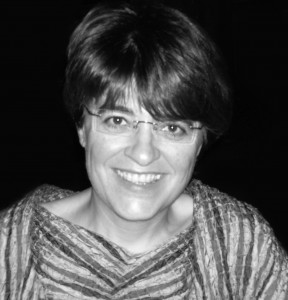Letizia Modena
 Letizia Modena
Letizia Modena
Associate Professor of Italian
Furman Hall 222
Education
Laurea, University of Bologna, Italy
M.A., University of Virginia
Ph.D., John Hopkins University
Research Interests
I love cities, fiction, and film, separately and combined. My research revolves around the interplay of place and identity, specifically, the intersections of literature and film with architecture and urban studies. In Italo Calvino’s Architecture of Lightness: The Utopian Imagination in an Age of Urban Crisis (Routledge, 2011), I revealed Calvino’s sustained dialogue with architects and urban planners in the 1960s and 70s.
Presently, I am mapping out a book that explores the complex and continuous exchanges between a selection of Italian 20th- and 21st-century novelists, architects, and urban planners. In it I explore ways in which contemporary Italian fiction might renew our perception of the city. More immediately, how can literature enhance our individual and collective relationships with the built environment and social realities of the 21st century?
According to Calvino, the public intellectual “helps us forget that which we recall too well: ideas given to us, words given to us, images given to us, which stop us from seeing and thinking and saying the new.” This assertion struck me a lot, several years ago, compelling me to interrogate the ethical dimensions of literature in relation to imagination and cognition. How might fiction make us “see and think and say the new,” as Calvino put it, in a way that contributes to a better understanding and planning of the city? Conversely, how can urban studies possibly contribute to fictional narrative? What do architects in particular take from literature and what might they give back? Is such an exchange even possible, and, if it is, how and why is it relevant to literary and cultural historians such as ourselves?
http://www.routledge.com/books/details/9780415880381/
Representative Publications
Books
 Italo Calvino’s Architecture of Lightness: The Utopian Imagination in an Age of Urban Crisis. New York and London: Routledge, 2011.
Italo Calvino’s Architecture of Lightness: The Utopian Imagination in an Age of Urban Crisis. New York and London: Routledge, 2011.
Articles
“The Architect, the Writer, and the Detective: Gianni Biondillo’s Milan from the Margins, or the Education of the Gaze.” Symposium: A Quarterly Journal in Modern Literatures. 72.2 (2018): 63-76.
“Senza raccontarli i luoghi non esistono”: Il GRA di Roma tra urbanistica e transmedia storytelling.” Forum Italicum: A Journal of Italian Studies. May 2016 50: 194-221, first published on March 21, 2016
“In questa non-piazza un parcheggio…una lastra d’asfalto piombata lì a far ribollire l’estate”: la provincia romagnola e il non-luogo nell’opera di Giovanni Nadiani.” Bel Paese? La rappresentazione del paesaggio nella letteratura e nel cinema dell’Italia contemporanea (The Representation of Landscape in Contemporary Italian Literature and Cinema). Eds. Luca Pocci and Paolo Chirumbolo. Lewiston, New York: Mellen Press (2012).
“Italia plurale: orgoglio e pregiudizio, o Giorgio Diritti, Il vento fa il suo giro.” L’altro e l’altrove nella cultura contemporanea. Cuneo: Nerosubianco Edizioni. Ed. Fulvio Orsitto. (2011).
“‘Pestis illa fantasmatum’: Petrarca, il Secretum e Sant’Agostino, riflessioni preliminari su peste e immagine” (“‘Pestis illa fantasmatum’: Petrarch, the Secretum, and St. Augustine. Preliminary Reflections on Plague and Image”). Special issue of Italian Quarterly dedicated to Salvatore Camporeale. Eds. Francesco Ciabattoni and Susanna Barsella (2011).
“A Proposal for the Foreign Language Curriculum: Teaching Primo Levi in An Advanced Language Course. ” Approaches to Teaching the Writings of Primo Levi. Eds. Roberta Ricci and Nicholas Patruno. New York: Modern Languages Association (2011).
“Stranger in the Mirror: Forsaking the Past, Foreclosing the Future in Giorgio Diritti’s Il vento fa il suo giro. Jura Gentium Cinema. Special Dossier “Reflections Upon Contemporary Italian Cinema.” http://www.jgcinema.com/single.php?sl=migrazioni-razzismo. 2011.
“Andrea Molaioli: il silenzio della profondità.” Interview-Essay. Zoom “d’oltreoceano”: istantanee sui registi italiani e sull’Italia. Rome (Manziana): Vecchiarelli Eidtore, 2010. Eds. Daniela De Pau and Simone Dubrovic. 285-306.
“La leggerezza ascensionale tra umanesimo e postmodernismo: Boccaccio, Calvino e l’emblema di Cavalcanti” (“Ascending Lightness Between Humanism and Modernism: Boccaccio, Calvino, and the Emblem of Cavalcanti”). Italian Quarterly171-172 (Winter-Spring 2007): 31-44 (published Spring 2009).
“Italo Calvino e la saggistica del magma: verso un’altra genealogia della leggerezza” (“Italo Calvino and the Early Essays on Magma: Towards Another Genealogy of Lightness”). MLN 123. 1 (2008): 40-55.
“Incorporeità e sacro nella poesia neo-dialettale: Franco Loi, il vento e l’aria” (“The Incorporeal and the Sacred in Neo-Dialect Poetry: Franco Loi, Wind, and Air”). Italica 85.2-3 (Summer 2008): 210-225.
“‘Mi veniva da scrivere città sottili come le sue sculture’: la scultura di Fausto Melottinelle Città Invisibili di Italo Calvino” (“‘I Felt Like Writing Thin Cities Like His Sculptures’: Fausto Melotti’s Sculptures in Italo Calvino’s Invisible Cities”). Letteratura & Arte 2 (2004) (published 2005): 217-242.
“Carlo Emilio Gadda. Acquainted with Grief.” World Literature and Its Times 7: Italian Literature and Its Times. Ed. Joyce Moss. Detroit: Thomson Gale, 2005. 1-10.